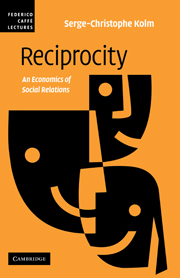Book contents
- Frontmatter
- Contents
- List of illustrations
- Foreword
- Introduction
- Part I Facts and forms
- Part II Motives
- 5 The three worlds of reciprocity
- 6 Balance reciprocity
- 7 Liking reciprocities
- 8 Other reciprocities: continuation, relational, imitation, extended
- 9 Reciprocity and social sentiments
- 10 Reciprocity in the modes of economic realization
- Part III Values and reasons
- Part IV The economics of reciprocity
- Bibliography
- Index
7 - Liking reciprocities
Published online by Cambridge University Press: 22 September 2009
- Frontmatter
- Contents
- List of illustrations
- Foreword
- Introduction
- Part I Facts and forms
- Part II Motives
- 5 The three worlds of reciprocity
- 6 Balance reciprocity
- 7 Liking reciprocities
- 8 Other reciprocities: continuation, relational, imitation, extended
- 9 Reciprocity and social sentiments
- 10 Reciprocity in the modes of economic realization
- Part III Values and reasons
- Part IV The economics of reciprocity
- Bibliography
- Index
Summary
Introduction
“Friends make gifts and gifts make friends”, an Inuit proverb says. This pair of relations proposes a reason for reciprocity in giving when taken in reverse order, and in friendship, or liking one another, when taken in this order. However, not all gifts make friends, only friendly ones. Hence, one may in fact only have “friendship makes friendship”, a direct reciprocity in sentiment, plus the easily understandable “friends make gifts” and a possible role of giving for informing about liking. Staying with folk wisdom, this is what a beautiful old song expresses in saying J'aimerai qui m'aimera (I will love him who loves me). Nevertheless, although folk wisdom epitomizes respectable experience, it is no substitute for explanation. If “liking elicits giving” is rather straightforward, “receiving a gift elicits liking the giver” requires closer explanation and analysis of its conditions, and “liking elicits liking” still more so.
These reciprocities based on liking constitute one of the main fields in the realm of reciprocity (along with balance reciprocity and self-interested continuation). Moreover, reciprocity in liking is a main social bond, with essential manifestations from general sociality to family love, the constitution of groups, and the nature of communities. Liking reciprocities also have a major direct normative value for the quality of society and of the relationships and people in it. Hence, understanding and explaining liking reciprocities is a major task.
- Type
- Chapter
- Information
- ReciprocityAn Economics of Social Relations, pp. 116 - 133Publisher: Cambridge University PressPrint publication year: 2008

